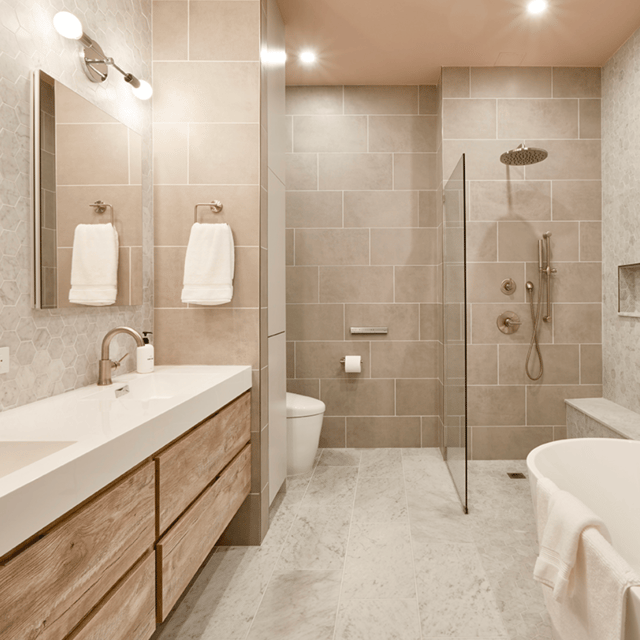
Bathroom
New York City Bathroom Remodels: Planning & Renovation Tips
12.05.2025

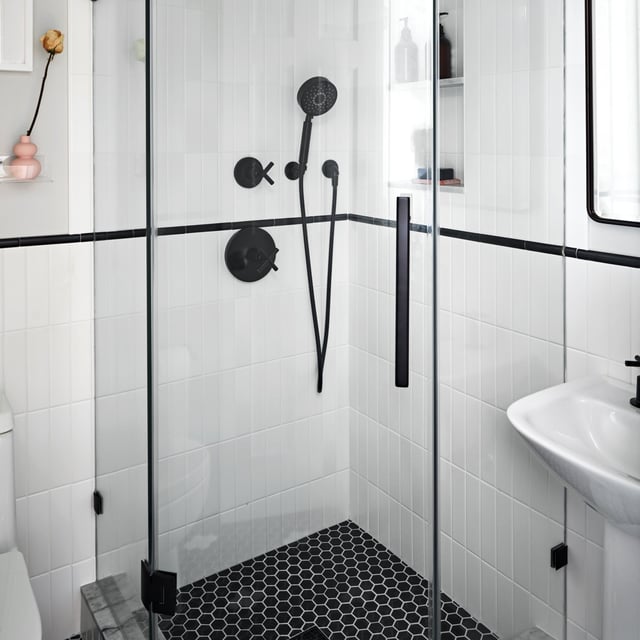
In This Article
If you're considering converting a half bathroom into a full bathroom, you're part of a growing trend among homeowners looking to increase home value, improve convenience, and accommodate expanding families. A half-to-full bath conversion is a smart investment that can enhance both functionality and resale appeal. Before starting your renovation, it’s important to understand what the process entails. In this guide, we’ll cover the key benefits, average costs, space planning strategies, and what to expect when upgrading your half bath to a full bathroom.
First, let’s break down the difference between a half and a full bathroom. A half bathroom—also known as a powder room or guest bathroom—typically consists of just a toilet and sink. On the other hand, a full bathroom includes a toilet, sink, and either a bathtub, shower, or both. Adding a shower or tub to your half bath is the key element of converting it into a full bathroom.
Design a Home That’s Uniquely Yours
Block can help you achieve your renovation goals and bring your dream remodel to life with price assurance and expert support.
Get Started
Before diving into the project, there are several important factors to consider. These will help ensure the process goes smoothly and that you’re happy with the final result. Additionally, we'll discuss potential challenges you might face during the conversion and how to overcome them.
One of the first things you’ll need to figure out is whether you have enough space to add a shower or bathtub. The typical space required for a full bathroom is around 40 square feet. However, there are ways to make it work with less, depending on your layout and the fixtures you choose. Keep in mind that adding a shower stall requires about 15 square feet of space, and a bathtub takes around 30 square feet. You may need to steal some square footage from a neighboring room, closet, or hallway to make it happen.
Next up is the plumbing. Adding a shower or tub requires more extensive plumbing than a simple toilet and sink. You’ll need to ensure that your existing plumbing can handle the additional fixtures and that your water heater is capable of supplying hot water to the new setup. If your plumbing isn’t already nearby, you’ll have to run new pipes, which can add to the overall cost and complexity of the project.
Good ventilation is critical in a full bathroom to prevent moisture buildup, which can lead to mold and mildew. Make sure there’s adequate ventilation either through a window or an exhaust fan. If you're installing a shower or bathtub where one didn’t exist before, adding ventilation may be a necessary part of the process.
Don’t forget about the electrical work! Adding a shower may require new lighting, an exhaust fan, or even heated floors, all of which will need proper wiring and outlets. If your home’s electrical system isn’t up to code or can’t handle the additional load, you may need to upgrade your electrical panel.
Renovate with confidence every step of the way
Step 1: Personalize Your Renovation Plan
Step 2: Receive Quotes from Trusted Contractors
Step 3: Let Us Handle the Project Details

On average, you can expect to pay between $5,000 and $25,000 for a half-to-full bathroom conversion, including the costs of materials, labor, and any necessary permits. The lower end reflects budget-friendly materials and minimal plumbing work, while the higher end includes more extensive renovations and premium materials. While the best way to determine the project budget is to receive quotes from multiple qualified contractors, below is a breakdown of individual renovation elements that often go into converting a half-bath into a full.
If you’re looking to transform an existing powder room, you’re likely prioritizing space-saving solutions like a walk-in shower. As detailed in our guide, How Much Does a Walk-In Shower Cost?, adding a prefabricated shower typically costs between $600 and $2,500, while a custom-built shower can reach up to $5,200. These figures do not include the potential need for plumbing adjustments, which are often required when adding a shower to a half-bath and can add another $600 to $1,500 to your project.
Converting a half-bath to a full bath means your space will be exposed to much more water, making thorough waterproofing essential. Full baths are especially susceptible to splashing and moisture buildup, particularly around showers and tubs. To prevent leaks, mold, and long-term damage, contractors apply waterproof membranes to walls and floors, seal all joints, and use materials designed for wet environments. Investing in proper waterproofing is crucial for the longevity and safety of your new bathroom.
For most half-to-full bath conversions, homeowners should budget an additional $800 to $2,000 for comprehensive waterproofing, depending on the size of the room and the products selected.
Upgrading from a half bath to a full bath almost always means rethinking your flooring. The addition of a shower or tub brings more moisture and foot traffic, and if you’re moving walls or expanding the space, your old flooring may no longer fit or match the new layout. Flooring that worked for a small powder room—like basic vinyl or wood—may not be durable or water-resistant enough for a full bathroom, where splashing and humidity are daily realities. Plus, if you’re adding new plumbing or moving fixtures, sections of the floor will likely need to be opened up and replaced.
For a typical 40-square-foot bathroom, budget-friendly flooring options like sheet vinyl or standard ceramic tile start around $400–$800 installed. Mid-range choices, such as porcelain tile or luxury vinyl plank, usually fall between $800–$1,600. If you’re looking for a high-end finish—like natural stone, marble, or custom tilework—expect to pay $1,600–$3,000 or more for the same space. When planning your half-to-full bath conversion, it’s important to select a flooring material that stands up to water, is easy to clean, and complements the overall design of your new full bath.
In some homes, the existing half bath simply doesn’t have enough square footage to comfortably fit a shower or tub. In these cases, moving or removing a wall may be necessary to create the space required for a true full bath.
This process can be complex, especially if the wall is load-bearing or contains plumbing, electrical, or HVAC lines that need to be rerouted. The cost to move a non-load-bearing wall typically ranges from $2,000 to $5,000, while moving a load-bearing wall can cost $5,000 to $10,000 or more, depending on the structural work involved and the need for permits or engineering plans.
Expanding the footprint of your former half-bathroom will also increase the cost of finishes, waterproofing, and labor, so it’s important to factor these additional expenses into your overall conversion budget. If you’re considering this option, consult with a qualified contractor to ensure the work is done safely and in compliance with local building codes.
Transparent Pricing You Can Trust

Converting a half bath into a full bath isn’t just a matter of picking out tiles and fixtures—it also involves meeting building codes and obtaining the proper permits.
Permits
Most bathroom conversions will require permits, especially if you’re moving plumbing, electrical, or structural elements. Depending on where you live, you may need permits for plumbing, electrical work, and general construction. Be sure to check with your local municipality to find out what’s required in your area.
Building codes are in place to ensure the safety and functionality of your bathroom. For example, there are codes that dictate the minimum ceiling height, the distance between fixtures, and ventilation requirements. Working with a licensed contractor can help ensure that your project meets all local building codes.
When working with limited space, good design is key. You’ll want to maximize every square inch to make your new full bathroom feel spacious and functional.
Don’t let a small bathroom deter you from converting it into a full bath! There are plenty of creative design solutions to make a small bathroom feel bigger. Consider opting for a corner shower, which takes up less space than a traditional shower. You can also choose a wall-mounted sink or a floating vanity to free up floor space. Glass shower doors, rather than a shower curtain, can also create the illusion of more room.
For inspiration for your half-bath-to-full conversion, take note of this compact Brooklyn bathroom. It makes the most of its 40 square feet by leveraging many of the tips above, including the installation of a corner shower with glass doors.

The fixtures you choose will have a huge impact on both the style and function of your new bathroom. Consider the following when making your selections:
Compare Proposals with Ease

The materials and finishes you choose will determine the overall look and feel of the bathroom. Here are some tips:

While every project is different, here’s a basic rundown of the steps involved in converting your half bath into a full bath:
Turn your renovation vision into reality
Get matched with trusted contractors and start your renovation today!
Find a Contractor
Turning a half bath into a full bathroom is a smart way to add comfort, convenience, and value to your home. When done thoughtfully, this renovation addresses everything from space limitations and plumbing upgrades to waterproofing and design, transforming an underused powder room into a practical, inviting space for your household and guests. With the right planning and expert support, a half-to-full bath conversion can make daily routines easier and boost your home’s appeal to future buyers.
Block Renovation is here to guide you through every step of the process. We work with a highly selective network of experienced contractors who understand the unique challenges of bathroom conversions—whether you’re dealing with tight city spaces or older homes with complex plumbing. Our team provides clear communication, transparent pricing, and personalized guidance, so you can move forward with confidence. With Block, you get more than just a contractor—you get a trusted partner dedicated to making your renovation smooth, successful, and tailored to your needs.

Written by Jordi Lippe-McGraw
Jordi Lippe-McGraw
How Do You Choose the Right Contractor for a Bathroom Conversion?
How Long Does It Take to Complete a Half Bath to Full Bath Conversion?
What Are the Most Common Challenges During a Bathroom Conversion?
Will Converting a Half Bathroom to a Full Bathroom Increase My Home’s Value?
How Can I Maximize Space in a Small Full Bathroom?
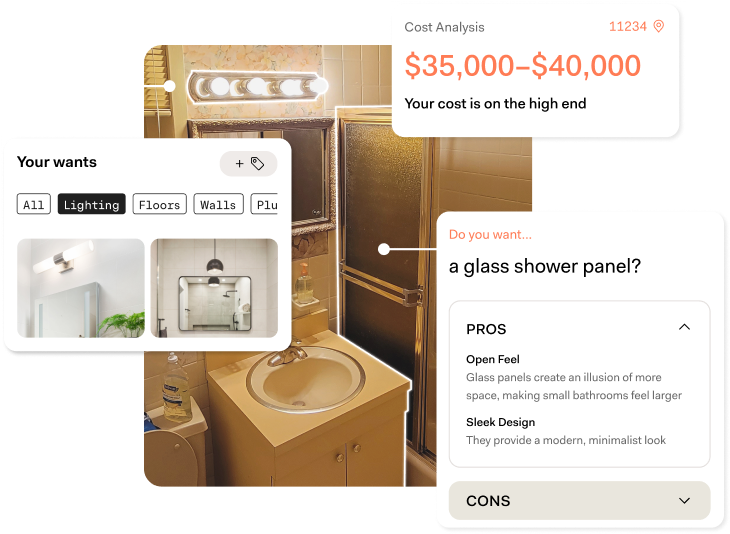
Calculate the true cost of your bathroom remodel
Get real-time cost estimates for materials and labor, so you can budget your renovation with confidence—no guesswork.

Bathroom
New York City Bathroom Remodels: Planning & Renovation Tips
12.05.2025

Bathroom
Slanted Roof Bathrooms and Shower Design Ideas
11.22.2025
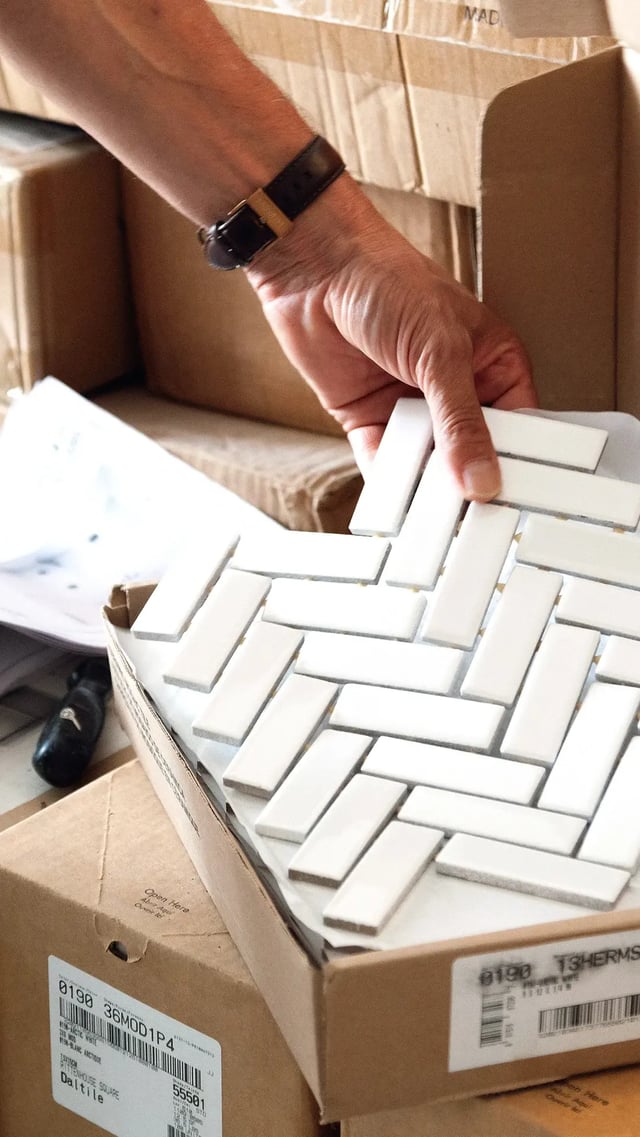
Contractors
50 Most Common Home Renovation Questions (Answered by Experts)
10.28.2025

Bathroom
Choosing Bathroom Fixture Finishes - Inspiration & FAQ
10.22.2025
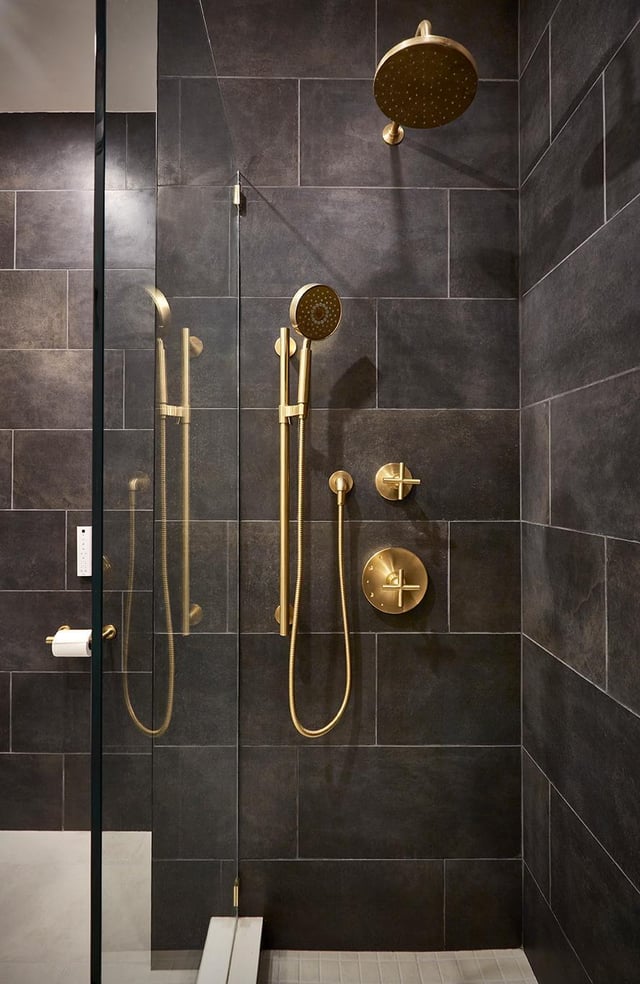
Bathroom
Designing a 40-Square Foot Bathroom? Here’s What Actually Matters
10.22.2025
Renovate confidently